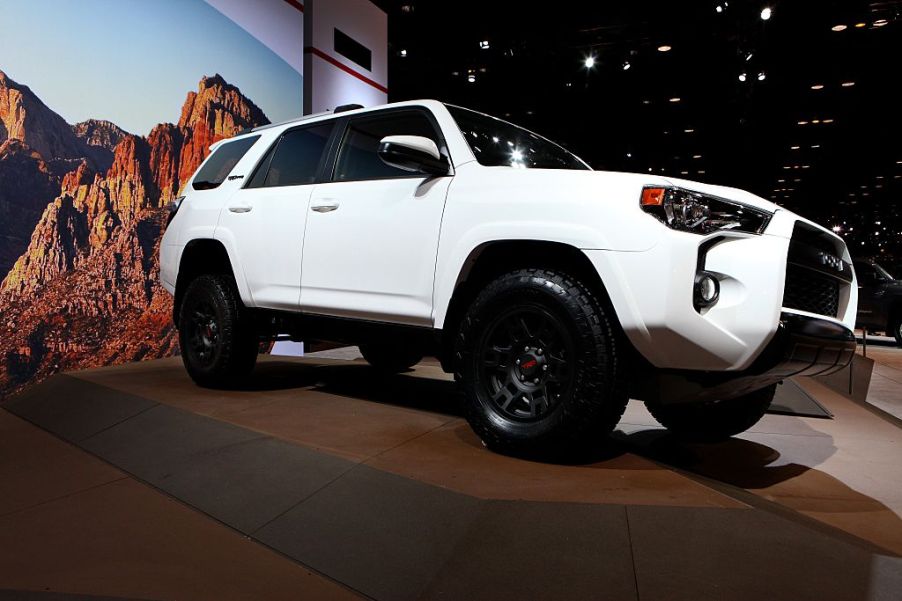
The 2020 Toyota 4Runner Is Disappointing Despite Its Reliability
When Toyota introduced the first LandCruiser FJ40 to the US in 1958, it was the start of a love affair for Americans who wanted an off-road driving experience. Since then, Toyota has kept up its end of the bargain by adding more SUVs to the lineup, and the Toyota 4Runner remains one of the most popular choices for families and off-roaders alike.
The Toyota 4Runner still handles like a truck

The 2020 Toyota 4Runner has some new bells and whistles that add to cabin comfort, but it is still, at heart, an off-roader. That’s because the construction is still the old body-on-frame design that only a few manufacturers still use – Tahoes, Suburbans, Yukons, Expeditions, and Wranglers are the others. And what do these have in common? They’re the real off-roaders of the SUV universe – built for crawling up the side of a mountain more than sitting at stoplights.
What’s disappointing in the Toyota 4Runner is that the same frame construction that makes it such a great SUV for bumping over ruts and rocks has a negative effect on the in-town ride. There isn’t much flexibility in this SUV; it’s built to hold firm over bad terrain and while hauling a heavy load. This design is tough at the pumps, too – the old V6 engine has a maximum fuel efficiency of 18 MPG.
Crossover SUVs feature the unibody style, which is suited for driving on highways and isn’t as rigid, allowing for better handling, a smoother ride, and better fuel efficiency.
Cabin upgrades for 2020 hit the mark
Toyota 4Runner models still suffer from looking a lot bigger than the cabin actually is–there’s not much headroom and a relatively big climb to get in. The finishing trim is plastic and looks like it, though the pricier models sport some faux wood-grain to dress it up a little.
On the upside, Toyota has added a couple of features to the cabin that almost make up for the cheap-looking trim. The first is Toyota Safety Sense P (TSS-P) – standard on all 2020 4Runners. It’s a suite of smart technology features that includes adaptive cruise control, lane-departure warning, and a pre-collision sensor with autonomous braking.
The redesigned infotainment system bumps the screen size from 6.1 to 8 inches and includes Android Auto and Apple CarPlay compatibility. TSS-P data is in the instrument cluster, which has been updated with a bigger screen for the trip meter and fuel economy data. They’ve added two additional USB ports in the backseat, so the kids won’t need to fight over charging their devices.
Reliability is the hallmark of the 2020 Toyota 4Runner
Consumer Reports gives the 2020 4Runner consistently high marks for reliability – five out of five across the board in their testing and owner reviews. In fact, the only component of the engine that didn’t get the highest mark was the 2013 model, which got a rating of four for minor engine repairs. 4Runners are such workhorses that the average price for a 2010 model is $18,000; that reliability factor is a huge selling point in the resale market.
Reasons To Buy A 2020 Toyota 4Runner
No car is ever perfect, and the Toyota 4Runner does have its flaws. But the 4Runner is clearly something that’s in demand, and that’s probably because the styling and handling issues are not all that relevant to the target consumer.
When a professional driver road tests a car, they are unconsciously comparing it to all the other cars they drive, and there is no way a 4Runner compares to a high-end BMW in terms of comfort and handling. On the other hand, most families aren’t looking for those qualities in the vehicle that the kids and dogs inhabit. They’re looking for reliability, safety, decent looks, and good cargo space. Cup holders and USB ports are higher up on the want list than leather and walnut trim for the 4Runner buyer.


